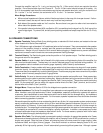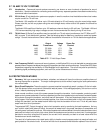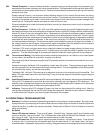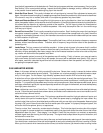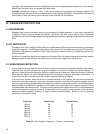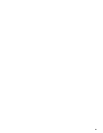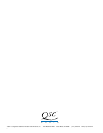16
3.83 Thermal Protection In case of blocked ventilation, improper loading or prolonged short-circuit operation, the
temperature of the power transistors can rise to excessive levels. If the temperature of the heat sink rises to 85C,
a thermostat will remove power to that channel. Power will be automatically restored when the channel has been
allowed to cool down.
Please note that Channel 1 can shut down without affecting channel 2, but if channel 2 shuts down, the muting
circuit for both channels will operate and mute channel 1 as well. This was done so that whichever channel might
overheat in the bridged-mono mode, it would remove the signal for both channels and prevent damage to the
muted channel. The amplifier should come back on within a minute or two.
If thermal problems occur, check for blocked ventilation, proximity to a heat source, short circuit, or improper load
(too many speakers).
3.84 DC Fault Protection The Model 1100, 1200, and 1400 amplifiers employ a unique Bi-Capacitive output circuit
that combines the tight, well controlled audio performance of direct-coupled (DC) designs with the inherent ability
to block DC output in the event of amplifier failure. Because this circuit requires dual power supplies, protection
is independent on each channel. A DC fault in one channel will not affect operation of the other. Since no relays
or other external devices are employed, the amplifiers are free from any false triggering or degradation problems
associated with other protection schemes. In the event of an actual fault, DC will be blocked at the output until
an internal protection fuse blows. This will remove power from the defective channel until repair can be made. In
the unlikely event this should happen, disconnect the inputs and speakers from the defective channel and take
the amplifier in for service as soon as possible, to prevent any further damage.
The Model 1700, due to its higher power rating, employs the same dual power supply scheme, but has a more
conventional direct coupled (DC) output circuit. It uses a heavy duty Load Grounding™ speaker relay for load
protection. This has the advantage of connecting the defective channel’s load to ground for extra protection.
3.85 Turn-on/turn-off Muting There will be a three-second muting interval after turn-on. After turn-off, or loss of power
for any reason, the amplifier will mute within a quarter of a second.
The outputs of all Series One power amplifiers are DC protected and the circuits have no inherent turn-on or turn-
off thumps.
Protective muting for the Model 1100 is handled by a small relay at the input. The signal does not pass through
the relay contacts, but is shunted to ground during the muting interval. Thus any degradation of the relay contacts
will only affect the muting, and not the audio quality.
The Model 1200, 1400 and 1700 make use of an electronic muting circuit to mute the input of the amplifier. The
Model 1700 also makes use of the Load Grounding™ relay to mute the output of the amplifier by grounding the
speaker output.
3.86 Input/Output Protection Series One amplifier inputs are isolated by 10K resistors, which are part of the balanced-
input circuit. This protects the inputs from burn-out due to extremely high input signals or RF interference. The
amplifier output is isolated from capacitive and inductive loads by a high frequency RLC network, which decouples
the speaker terminals slightly at frequencies above about 50 kHz.
3.87 Indicators The green pilot LED indicates AC power, but does not signal status of the muting circuit. After the
muting interval is passed, the red clip LED’s will indicate the presence of distortion for each channel. If distortion
is heard without clip indication, you should suspect other parts of the system.
3.9 OPERATIONAL TROUBLESHOOTING
3.91 Summary This Section contains troubleshooting hints which should help you locate a problem. By using a step-
by-step evaluation, by comparing the function of both channels, and by using one channel to check the inputs and
outputs of the other, a problem can usually be isolated. Please refer to Section 2.3 for an illustration of the front
panel and indicators.
3.92 No Sound
Power LED does not come on:
There is no AC power. Check AC plug. Depress the AC circuit breaker reset
on front of amplifier, next to AC switch. The 1700 features a combination AC Switch/Circuit Breaker—turn it off
then back on to reset. Test the wall outlet with another device to check for power.
Power LED comes on:
Either the input or output has a bad connection, or the channel is faulty. If one channel
is working, use it to test the input and speaker cable from the bad channel. If it still doesn’t work, the fault is
somewhere else—the speaker, input source, or cabling. If the good channel works using the bad channel’s cables,









